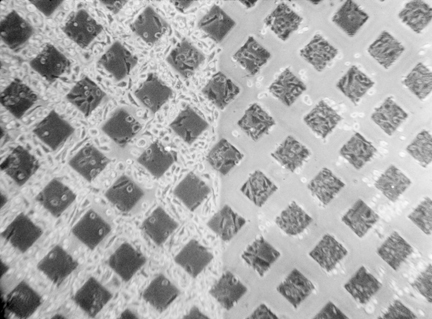"Opposite Behaviors" of Macrophages Unsolved Problems September 2, 2020
(Movements or responses that are the opposite of all other differentiated cell types)Although the Greek root "macro" means "big", macrophages are one of the smallest differentiated cell types in the body. However, they can phagocytize larger objects.
At least 14 different names are used to refer to macrophages depending on their location and/or origin in different parts of the body.
Monocytes
Microglia
Kupfer Cells
Dust Cells
Osteoclasts
Foam Cells
and others
#1) Proteolytic enzymes ("trypsin" meaning impure mixtures of pancreatic enzymes) and calcium chelators (usually EDTA) cause most tissue culture cells to round up, and are routinely used to transfer cell populations from one dish to another.
Macrophages differ in not rounding up when treated with trypsin or EDTA.
If anything, macrophages increase spreading in response to trypsin.
#2) Although most cells are inhibited from crawling under or over each other ("contact inhibition"), macrophages are somehow stimulated to accumulate underneath mesenchymal cells.
#3) On gradients of hydrophilic versus hydrophobic materials, nearly all tissue culture cells move onto the more hydrophilic surface (glass in preference to metal; metal in preference to cellulose acetate). But macrophages move onto more hydrophobic surfaces, in preference to hydrophilic.

Palladium metal was deposited in a grid pattern on both glass (left half of field) and cellulose acetate (right half of field). Cells have accumulated on the palladium in preference to cellulose acetate, but on glass in preference to palladium.
From Harris, A.K. (1973), Behavior of cultured cells on substrata of variable adhesiveness. Experimental Cell Research 17, 285-297.
#4) Roughened polystyrene somehow inhibits spreading of every kind of cell except macrophages, whose spreading is favored by roughening. Macrophages will run along scratched lines like trains on a track; but other cells stop at the edges of scratches.
video of macrophages on roughened polystyrene
Paper by my graduate student Abby Rich
#5) In voltage gradients, macrophages (and osteoclasts) move toward the positive electrode; Fibroblasts line up perpendicular to the gradient, and fish epidermal cells move toward the negative electrode (but if exposed to some ionophores will reorient toward the positive electrode!)
#6) Osteoclasts, a type of macrophage, dissolve bone.
---------------------------------------------------------------------------------------
The photograph in the Wikipedia article about macrophages looks nothing like an actual macrophage. On the other hand, the two videos near the end of this article really do show actual macrophages.
---------------------------------------------------------------------------------------